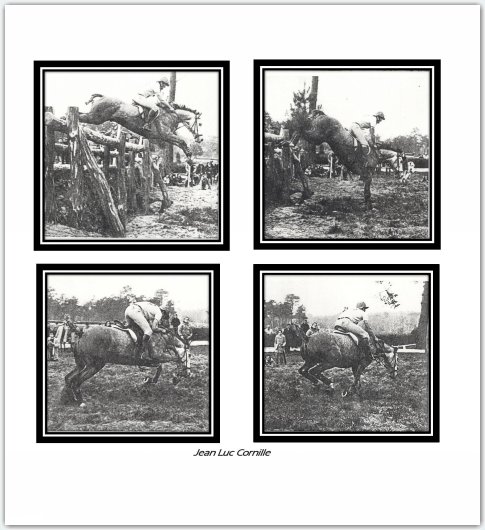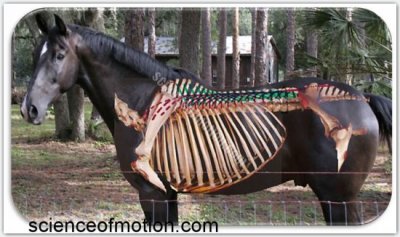Meaning of life pt 8
Meaning of life 8
Atoll II
Part 2
Jean Luc Cornille
"Feeling is just a perception and as long as feeling is not associated in the brain with a sound and updated understanding of equine biomechanics, feeling leads to misconceptions." Jean Luc Cornille

Atoll II was also highly sensitive to any shift of the rider’s weight. I learned through my steeple chase training about a balance more over the lower leg in contact with the horse and I naturally adapted my two points position to this more forward balance. I did not think too much about it until a time where I had a few broken ribs due to a fall in steeple chase and asked to a friend to keep the conditioning of my horse. The work was simply a canter work on the track. Atoll was now in good balance and the slow canter that was part of his conditioning, was very pleasant. Atoll had a long stride and was capable of controlling his balance giving a light contact on the bit. My friend was a good rider. He was in fact a member of the three-day event international team and we both were very surprised by Atoll’s reaction. A horse that could canter seven to ten minutes nonstop sustaining almost the same speed all the time, was rushing, pulling heavily on the rider’s hands. I realized then that my friend was in a classic two points position instead of the remodeled two points position that I had intuitively adopted. My friend had great experience in jumping and three-day event but never rode or trained in steeple chase. He rode the steeple chases of the Three day events long format but never rode with the stirrups as short as on the race track nor he raced in steeple chase.
We talk about it and I explained him how to do it. He was a very good rider and he did not take long for him to figure and Atoll calmed down immediately. At the end of the conditioning session, my friend commented, “I always wondered why you ride like that. You don’t’ push your heels down like we are trained to do. You are in great balance but you don’t squeeze your lower thighs. From the knees down to the stirrup, your lower leg is like a supportive column and your body is balanced over this column. You look practically the same than in the traditional two points position and nobody ever noticed it but we work together quite often and I noticed these differences.” He added then like for himself, “That is probably why you never throw your body backward during the landing of a drop. I remember watching you at Saumur. You were coming too fast on the jump and the horse almost crashed at the landing. You stay forward lose reins and in balance and I was thinking, that the stability of your body allowed the horse to recover his balance. I am glad that this subject come up. I know about your interest for scientific researches, I can see some changes in the way you ride and train but you never talk about it. Now, I am intrigued and interested. I am going to further the thought.”
I did not talk about it because the practical application of scientific studies is a research in itself. The findings don’t come out ready to be applied. In fact, there are numerous examples where scientists are making good science but poor practical application. At this time, advanced understanding of equine biomechanics allowed me to better interpret my feeling but I was not capable to explain it. I was able to ride horses that other riders could not ride, not because I had more skill but because I was able to adapt. And the main reason why I was able to adapt is that even at this time, scientific studies had already demonstrated the inaccuracy of riding and training techniques preached and respected as the bible. I was wearing the uniform of a very classical riding school so I did not talk about it but I was studying and exploring for my own knowledge. I did not feel too bad about it since one of the great Riding Master of the Cadre Noir wrote, “Respect for tradition should not prevent the love of progress.”
Seating, or in two points position, shifts of the rider’s weight disturb proper coordination of the horse’s back muscles. In1946, Slipper did not talk about it but drew an illustration of the longissimus dorsi muscles that was completely different from the usual long bungee cords that were illustrated in books and magazines. The thought that the back muscles were long and working as a whole, corroborated equestrian theories but not the feeling given by the horses. At different sequences of the stride, it was easy to feel that one end of the longissimus muscular system worked totally differently that the other end. Combining scientific knowledge available at this time and experience riding upper level horses at the limits of their athletic abilities, I explored the thought that a more authentic and stable balance of the rider would minimize the work of the horse on long distances such as the ones asked during long country courses. Good horses succeed with riders moving more, but peculiar horse like Atoll could not take it. Also, the team vet noticed that my horses were less tired at the end of the course.
I keep quiet at this time because many of these observations questioned the veracity of traditionally accepted theories. Everyone knows that in the competitive world, the one selected on the team is not necessary the best rider but the one that please the selection committee. However, as it became more and more obvious that horses at every level benefited greatly from an education updated to advanced research studies, I took more and more the side of the horses.
This is the diagram published in 1949 by L J SLijper,  the fascicles of the longissimus dorsi muscles bridge a few vertebrae and are oriented oblique down and forward from the dorsl spine to the articular facets of the vertebrae. Tucker in 1964 and others including James Rooney in 1975 explained that the fascicles of the transversal spinalis muscles and in particular the multifidius, were oriented in the opposite direction, oblique, down and back. On the second diagram, the fascicles of the longisssimus are in red and the fascicles of the multifidius are in green. The coordinated action of these back muscles allowed managing the thrust generated by the hind legs into horizontal forces, forward movement, and vertical forces, resistance to gravity and at a more sophisticated level, balance control. Based on the setting of the back muscles, it was rational to explore the thought that the shifts of the rider
the fascicles of the longissimus dorsi muscles bridge a few vertebrae and are oriented oblique down and forward from the dorsl spine to the articular facets of the vertebrae. Tucker in 1964 and others including James Rooney in 1975 explained that the fascicles of the transversal spinalis muscles and in particular the multifidius, were oriented in the opposite direction, oblique, down and back. On the second diagram, the fascicles of the longisssimus are in red and the fascicles of the multifidius are in green. The coordinated action of these back muscles allowed managing the thrust generated by the hind legs into horizontal forces, forward movement, and vertical forces, resistance to gravity and at a more sophisticated level, balance control. Based on the setting of the back muscles, it was rational to explore the thought that the shifts of the rider weight promoted in traditional and even classic equitation were in contradiction with actual knowledge of the equine biomechanics. Later, when Hans Carlson demonstrated that the main function of the back muscles was protecting the thoracolumbar spine from an amplitude of movement that would exceed the thoracolumbar column’s possible range of movement, advanced understanding of equine biomechanics demonstrated the incongruity of riding technique promoting relaxation and stretching of the equine back and relaxation and looseness of rider’s back.
weight promoted in traditional and even classic equitation were in contradiction with actual knowledge of the equine biomechanics. Later, when Hans Carlson demonstrated that the main function of the back muscles was protecting the thoracolumbar spine from an amplitude of movement that would exceed the thoracolumbar column’s possible range of movement, advanced understanding of equine biomechanics demonstrated the incongruity of riding technique promoting relaxation and stretching of the equine back and relaxation and looseness of rider’s back.
Atoll benefited from the knowledge of equine biomechanics available at his time. It was elementary in the light of new knowledge but without the practical application of available knowledge Atoll would not have been rideable. Instead, he had a career at International level. Interestingly, even if he was rideable, Atoll remained a horse quite difficult to ride. During his career at the top level of three-day event he never had a fault on the country course and never knocked a rail down on the jumping course. The problem was the dressage. However, even If many knew the horse before, his successes were attributed to some mysterious skill that I have. Not one, at the exception of the very few that rode the horse, ever considered that it was indeed the practical application of advanced scientific knowledge. I was not applying classical views but instead upgrading classical views to new knowledge. All these events happened in the seventies and forty-five years later, the same resistance to progress is still locking otherwise skilled riders and talented horses in theories of the dark age. Jean Luc Cornille



 twitter
twitter facebook
facebook google
google stumbleupon
stumbleupon pinterest
pinterest yahoo
yahoo linkedin
linkedin